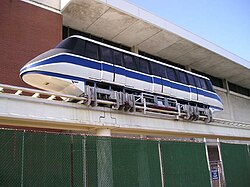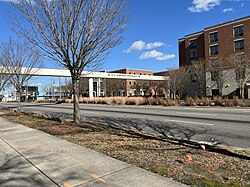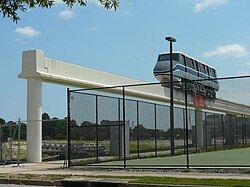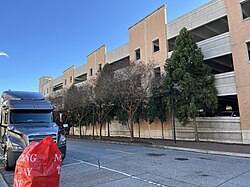
Personal rapid transit (PRT), also referred to as podcars or guided/railed taxis, is a public transport mode featuring small low-capacity automated vehicles operating on a network of specially built guideways. PRT is a type of automated guideway transit (AGT), a class of system which also includes larger vehicles all the way to small subway systems. In terms of routing, it tends towards personal public transport systems.

Transrapid is a German-developed high-speed monorail train using magnetic levitation. Planning for the Transrapid system started in 1969 with a test facility for the system in Emsland, Germany completed in 1987. In 1991, technical readiness for application was approved by the Deutsche Bundesbahn in cooperation with renowned universities.

Old Dominion University (ODU) is a public research university in Norfolk, Virginia. Established in 1930 as the Norfolk Division of the College of William and Mary, an extension school of the College of William & Mary for working professionals, members of the military, and non-traditional students in Norfolk-Virginia Beach area of the Hampton Roads region. The university has since expanded into a residential college for traditional students and is one of the largest universities in Virginia with an enrollment of 23,494 students for the 2023 academic year. The university also enrolls over 600 international students from 99 countries. Its main campus covers 250 acres (1.0 km2) straddling the city neighborhoods of Larchmont, Highland Park, and Lambert's Point, approximately five miles (8.0 km) north of Downtown Norfolk along the Elizabeth River.

Maglev is a system of train transportation that is levitated along a guideway through the use of magnetic forces. By levitating, maglev trains remove the rail-to-wheel contact present in conventional railways, eliminating rolling resistance.

Morgantown Personal Rapid Transit is a personal rapid transit (PRT) system in Morgantown, West Virginia, United States. The system connects the three Morgantown campuses of West Virginia University (WVU) and the city's downtown area.
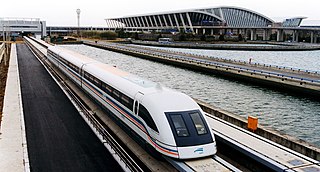
The Shanghai maglev train (SMT) or Shanghai Transrapid is a magnetic levitation train (maglev) line that operates in Shanghai, China. The line uses the German Transrapid technology. The Shanghai maglev is the world's first commercial high-speed maglev and has a maximum cruising speed of 300 km/h (186 mph). Prior to May 2021 the cruising speed was 431 km/h (268 mph), at the time this made it the fastest train service in commercial operation.

The Aérotrain was an experimental Tracked Air Cushion Vehicle (TACV), or hovertrain, developed in France from 1965 to 1977 under the engineering leadership of Jean Bertin (1917–1975) – and intended to bring the French rail network to the cutting edge of land-based public transportation.

The SCMaglev is a magnetic levitation (maglev) railway system developed by Central Japan Railway Company and the Railway Technical Research Institute.

Kornblau Field at S.B. Ballard Stadium, formerly Foreman Field, is a 21,944-seat multi-purpose stadium on the campus of Old Dominion University in Norfolk, Virginia. It opened in 1936 with a football game between the University of Virginia and the College of William & Mary's Norfolk Division, which is now Old Dominion University. It is currently the home of Old Dominion Monarchs football.
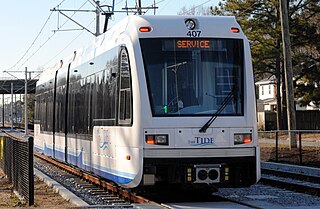
The Tide is a 7.4 mi (12 km) light rail line in Norfolk, Virginia, United States, owned and operated by Hampton Roads Transit (HRT). It connects Eastern Virginia Medical School, downtown Norfolk, Norfolk State University, and Newtown Road. Service began on August 19, 2011, making it the first light rail system in Virginia. Fares match local bus fares and the line accepts HRT's GO Passes. Trains generally run every 15 minutes, increasing to every 10 minutes during peak periods and every 30 minutes during early mornings and late evenings. In 2022, the system had a ridership of 732,700, or about 2,800 per weekday as of the third quarter of 2023.

The Old Dominion Monarchs football program represents Old Dominion University in U.S. college football. The first iteration of the team created in 1930 was known as the William & Mary Norfolk Division Braves. Founded in 2009, the current Monarchs team competed as an FCS independent for their first two seasons. In the 2011 season, they joined the Colonial Athletic Association and added conference games to their schedule, playing there until joining the Conference USA of the FBS in 2014. They joined the Sun Belt Conference in 2022.

Skytran is a personal rapid transit system concept. It was first proposed by inventor Douglas Malewicki in 1990, and is under development by Unimodal Inc. A prototype of the skyTran vehicle and a section of track have been constructed. The early magnetic levitation system, Inductrack, which SkyTran has replaced with a similar proprietary design, has been tested by General Atomics with a full-scale model. In 2010, Unimodal signed an agreement with NASA to test and develop skyTran. skyTran has proposed additional projects in France, Germany, India, Indonesia, Malaysia, the United Kingdom, and the United States.
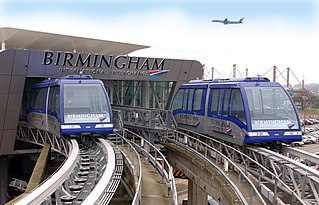
The Air-Rail Link is a people mover linking Birmingham Airport with Birmingham International railway station and the National Exhibition Centre in England. The current system, originally known as SkyRail, replaced the earlier Birmingham Maglev system in 2003.
The ACT, acronym for Automatically Controlled Transportation or Activity Center Transit, was a people mover system developed during the 1970s. One feature of the ACT is that it allowed bi-directional travel on a single rail—cars passed each other by switching onto short bypass lanes on the track, distributed where space allowed. ACT was a contender in the Urban Mass Transportation Administration's plan to deploy three or four systems in cities in the United States, as well as the GO-Urban project in Toronto, Canada. One ACT system was installed as a part of a Ford-funded real estate development near their headquarters in Dearborn, MI, and although they proposed to install ACT in several other locations, no additional systems were ever installed and the project was put on indefinite hold.
ROMAG was a personal rapid transit (PRT) system produced by the American company Rohr, Inc. It featured a linear induction motor that was arranged to provide both traction and suspension in a magnetic levitation system.

Tracked Hovercraft was an experimental high-speed train developed in the United Kingdom during the 1960s. It combined two British inventions, the hovercraft and linear induction motor, in an effort to produce a train system that would provide 250 mph (400 km/h) inter-city service with lowered capital costs compared to other high-speed solutions. Substantially similar to the French Aérotrain and other hovertrain systems of the 1960s, Tracked Hovercraft suffered a similar fate to these projects when it was cancelled as a part of wide budget cuts in 1973.
Krauss-Maffei's Transurban was a 12-passenger automated guideway transit (AGT) mass transit system based on a maglev guideway. Development started in 1970 as one of the many AGT and PRT projects that followed in the wake of the HUD reports of 1968. Its selection as the basis of the GO-Urban system in Toronto in 1973 made it well known in the industry; it would have been the basis of the first large-area AGT mass transit network in the world. Technical problems cropped up during the construction of the test track, and the sudden removal of funding by the West German government led to the project's cancellation in late 1974. The Ontario government completed development and installation of a non-maglev version, today known as the Bombardier Advanced Rapid Transit.

The University of the Philippines Diliman AGT was an automated guideway transit (AGT) system constructed for technology demonstration within the campus of the University of the Philippines (UP) in Diliman, Quezon City in the Philippines. It served as a test track for the first mass transit system to be built and developed in the country by local engineers.
American Maglev Technology (AMT), sometimes referred to as just American Maglev, is an American company founded in 1994 focused on creating maglev systems for public transit based in Amelia Island, Florida with former locations in Mariette, Georgia, and in Volusia County, Florida. It is led by CEO, Tony Morris and vice president Jordan Morris. The company has a working maglev test track located in Powder Springs, Georgia and formerly had one in Volusia County, Florida before moving locations. The company has invested more than $50 million into its research and development projects.
